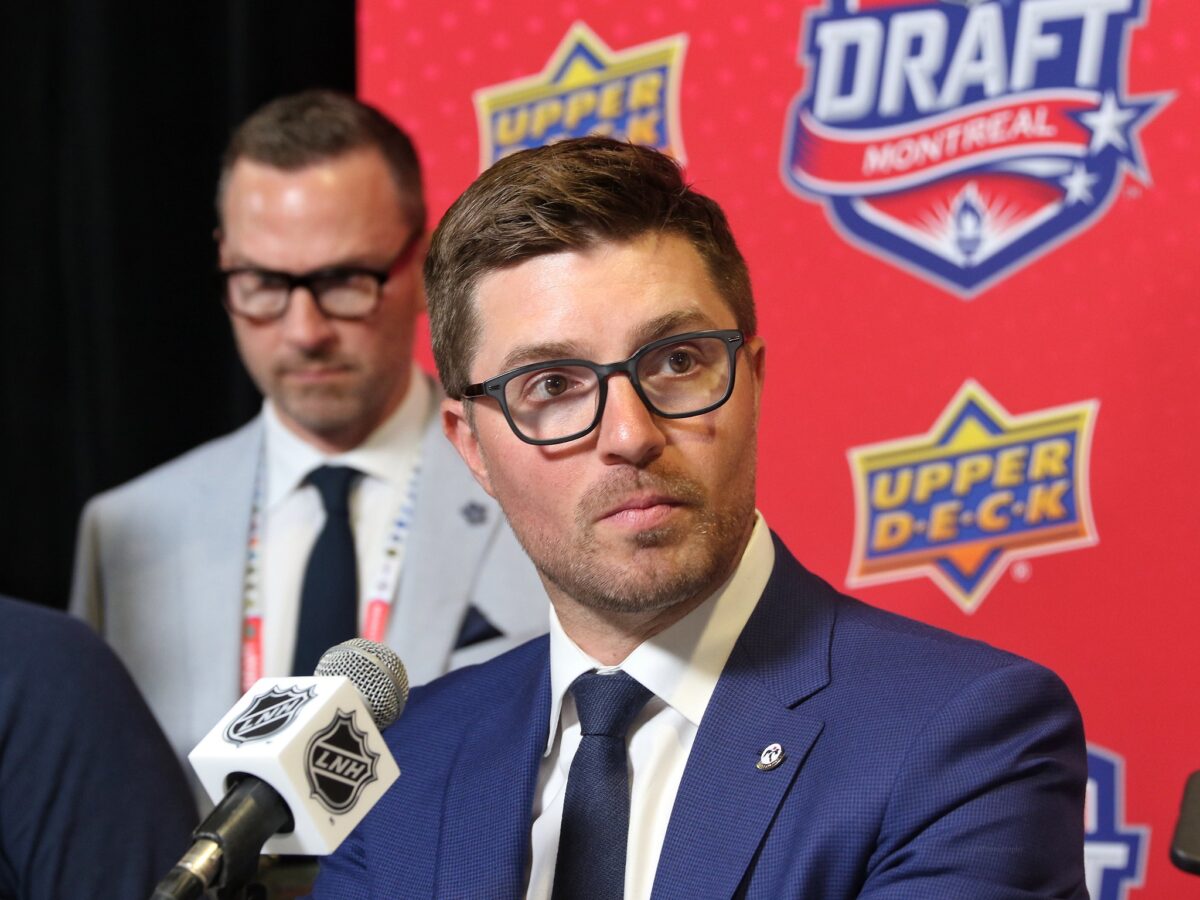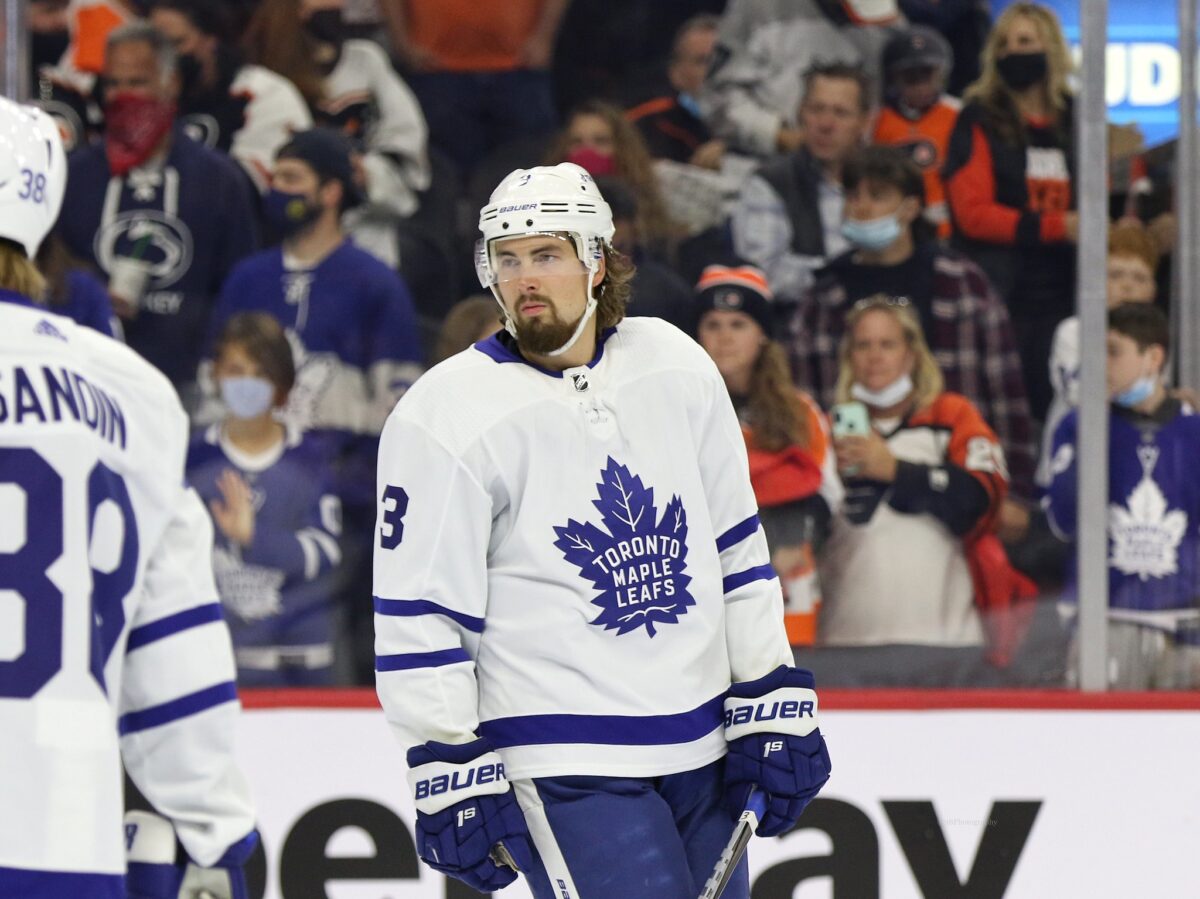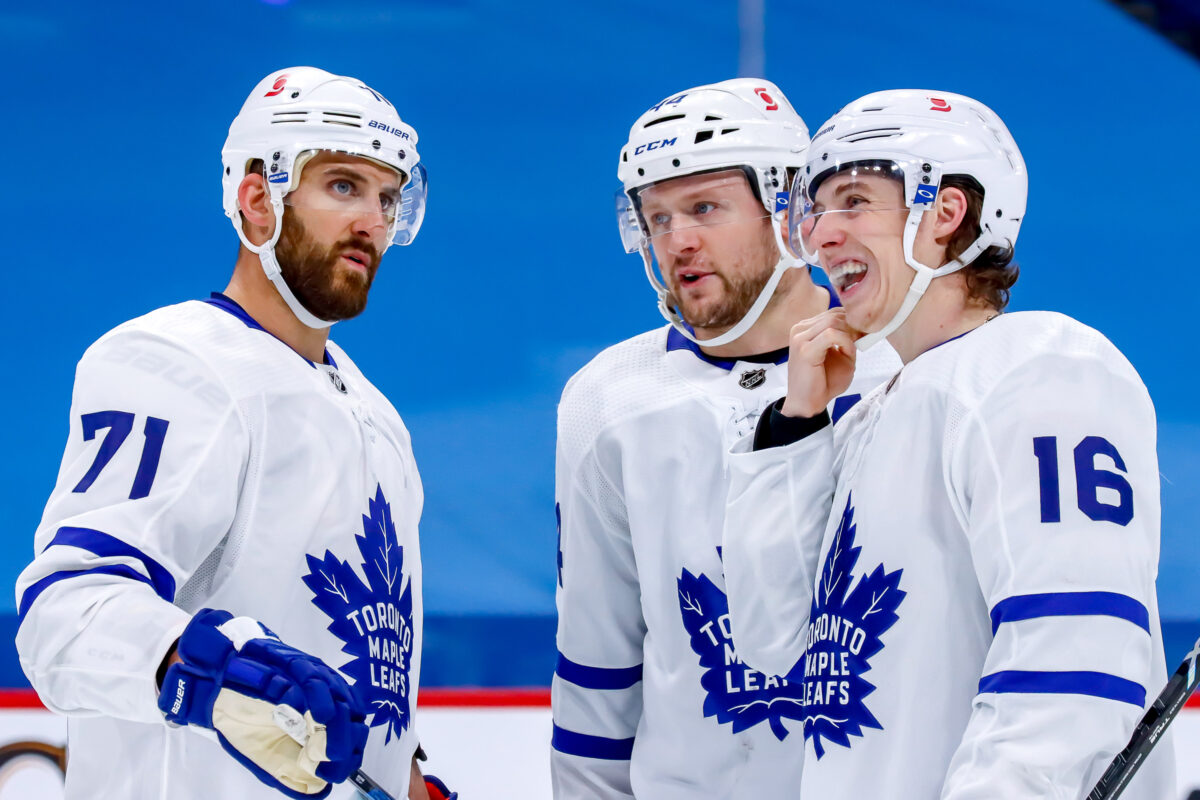When the Seattle Kraken entered the league during the 2021 offseason, there was a swirl of rumours around the Toronto Maple Leafs (as there always is) about their plans for the expansion draft. A month and a half after a bitter ending to the 2020-21 Playoffs, in which they suffered arguably their most embarrassing collapse of the long-standing streak, it was announced that the team had acquired forward Jared McCann from the Pittsburgh Penguins in exchange for prospect Filip Hallander and a seventh-round pick.
Related: 3 Teams With Most to Lose in 2022-23 Season
With the option to protect seven forwards, three defensemen, and a goaltender, the decision to protect McCann seemed like a no-brainer. Especially with the Maple Leafs having three defensemen who appeared to be in an echelon of their own in Morgan Rielly, T.J. Brodie, and Jake Muzzin. But, in a surprising turn of events, they opted to go with the alternative and protect four forwards, four defensemen, and a goaltender instead. With that, they protected defenseman Justin Holl on top of the aforementioned defensemen, left McCann exposed, and the Kraken took advantage by selecting him from the Maple Leafs.

The decision was a hard pill to swallow for most fans. Partially because it seemed as though Dubas teased them with a shiny new piece for the top six in McCann, and then essentially gave him away to protect a player they already had and a non-core player at that. On the flip side, he had a reason for the moves that transpired before the day of the expansion draft, and it was a reason that may have made them seem like a tidy bit of work a year later. But, now that we’re here, it’s safe to say the move was one that didn’t work out and is arguably the worst of Dubas’ tenure.
The Maple Leafs’ Reasoning to Keep Holl, Expose McCann
To Dubas’ credit, there was a legitimate reason to hold onto Holl last season. I even wrote an article on it at the time. The Minnesota native was coming off arguably his most impressive season to date, spending the majority of it playing alongside Muzzin. After a long path to the NHL, Holl played his first full NHL season in 2019-20 and signed a three-year contract extension ahead of the 2020-21 season. From there, he formed a pairing with Muzzin, and the two of them were relied on in many high-pressure defensive situations. He even had a slight breakout season offensively, finishing the season with 20 points in 55 games.
With Holl having the season he did, there was reason to believe he was valued strongly around the league. And despite every mistake he’s ever made on the ice, it’s easy to see why Dubas would have been apprehensive about letting him go to Seattle for nothing. Take the fact that, at his best, he’s a 6-foot-3, right-handed defenseman with strong defensive awareness, some sneaky offensive ability, and a bit of a physical edge, too.
Now combine that with the fact that Holl is making $2 million a season, and had two years left on his contract at the time. In a league where a defenseman like Seth Jones had recently signed a deal worth $9 million per season, you can see how highly valued big, right-shot defensemen were, and still are across the league. Jones is obviously in a different class than Holl is, but it still supports the evidence around the way other teams view defensemen of that type. And, at the time, it was never a guarantee that the Maple Leafs were going to trade for Ilya Lyubushkin or let Timothy Liljegren slide into a full-time role. But, as we’ve seen with many of Dubas’ moves, the logic doesn’t always line up with reality.
Dubas Overestimated Holl’s Value to Maple Leafs
When I originally wrote my piece analyzing the decision to protect Holl last season, the main risk I cited in the piece was his play away from Muzzin. So, you can imagine the surprise that came when the narrative around his play completely shifted in 2021-22. Last season, he actually appeared to perform worse while playing alongside Muzzin. It didn’t help that the latter was battling injuries throughout most of the season, and in general, seemed like the two had a negative effect on each other.

Then, when Liljegren eventually secured a full-time spot on the roster, Holl’s value to the team shrunk in the sense that they had another option on the right side, and then again once they acquired Lyubushkin. It’s unfair to pin all of this on him, as he didn’t force Dubas to protect him, but the fact of the matter is that when the Muzzin-Holl pair stopped working, his role on the team fell into jeopardy. While he’s still a good penalty killer, the Maple Leafs had the pieces to do without him by the end of the season.
Had Dubas originally left Holl unprotected and gone the 7-3-1 route in terms of protecting players, the Maple Leafs may have had a better forward situation throughout the season. The need for a bonafide top-six forward to complement John Tavares and William Nylander became apparent throughout the season and is that much more prevalent now. McCann scored 27 goals on a Kraken team that finished last place in the Pacific Division last season. Had the Maple Leafs protected both him and Alex Kerfoot, it would have added further depth to their forward group, and potentially could have set them up better heading into this season, especially following the departures of Zach Hyman and then Ilya Mikheyev a year later.
How it Stacks Up Against Other Bad Moves
It may come as a surprise that I’m calling this the worst move of Dubas’ tenure, considering some of the other ones that have been made, but the difference between this one and the others comes down to one thing for me, and that’s logic.
Take the Nick Foligno trade, for instance. After trading a first-round pick and two fourth-rounders to acquire him, he wound up playing only 11 games in total and didn’t score a single goal. Looking back, it’s an awful move for sure. But at the same time, the market at the trade deadline is always inflated, and this move came only a year after the Tampa Bay Lightning paid a first-round pick for Barclay Goodrow, who had 24 points in 62 games at the time, and then later went on to win the Stanley Cup. If the logic was to pay the price for a veteran middle-six forward to add experience and grit to a team that needed it for a playoff run, then I can see why he did it. Also, let’s not forget about the success Foligno had shutting down the Maple Leafs in the playoff bubble the year before.

Another example, and this is a timely one, was the trade to acquire Denis Malgin for Mason Marchment. A trade that, looking back, you can say with confidence the Maple Leafs would have been better off keeping Marchment. At the time, the Leafs didn’t have space for him on their roster and moved him to make room for Malgin, who actually had three seasons of NHL experience under his belt at that point. Did the Maple Leafs give up on him too soon? Absolutely. But again, there was no telling at the time that he would be the player he is now.
Even the trade that sent Nazem Kadri to the Colorado Avalanche for Kerfoot and Tyson Barrie, I can say I understood the logic. Looking at the results for both teams a few years later, it’s obvious that the Avalanche won the trade in the end seeing that Kadri won a Cup with them while Barrie left the Maple Leafs after one season, and they’ve yet to win a round with Kerfoot. But, with the Maple Leafs having recently signed Tavares and Kadri getting suspended early in the playoffs for the second year in a row, it didn’t make sense for them to keep him and his cap hit. In the process, they added a younger player who could do the job for cheaper and a 60-point defenseman in addition. Did it work out for Toronto? Absolutely not. But at the very least, the logic behind it was understandable.
The difference between the protection of Holl and these other moves is that the latter made sense, at the time. Truth be told, despite the value that he may have carried last summer, it never really made sense to protect him in favour of a top-six winger who would have added a much-needed boost to an offense that went quiet when the stakes were highest. The Maple Leafs ultimately gave up a decent prospect in Filip Hallander and a conditional draft pick to ensure that no team took him, when we don’t even know that they would have.

As much as I generally believe Dubas has the best interest in mind for this team, the decision to protect Holl and sacrifice both a top-six winger and a prospect to do so is proving to be a mistake for the Maple Leafs more so a year later than it could have last offseason. Especially when it was a move that never really had to be made, and seems to be a result of the GM overthinking what should have been a simple decision.
Maple Leafs Have a Log Jam on Defense & a Hole to Fill Up Front
Another effect of protecting Holl at the expansion draft is that now the Maple Leafs have both a log jam of players on the back end, as well as a hole in the forward group that will have to be addressed at the deadline, if not before the season starts. With the recent signings of Victor Mete and Jordie Benn, the Maple Leafs will have eight defensemen on their roster, nine if you include the still-unsigned Rasmus Sandin. And, assuming no further moves are made, the team appears to be starting the 2022-23 season with Kerfoot as their second-line left winger.
You May Also Like
- Was Lou Lamoriello as Good as Maple Leafs Fans Remember?
- Ranking the Atlantic Division’s Goaltending Duos
- Maple Leafs News & Rumours: Foligno, Matthews, Stepan, & Bure
- Dubas & Lamoriello Enter New Season With One Last Chance
It seems unlikely that the Maple Leafs would have signed Benn and Mete with the intention of never playing them, and even though Sandin still remains a question mark for training camp, that still leaves them with more than enough depth on the back end heading into the season. You obviously can’t say that Holl being protected from the Kraken is directly connected to these two issues, but you have to wonder where the Maple Leafs would be as a team right now had they kept McCann after all.
